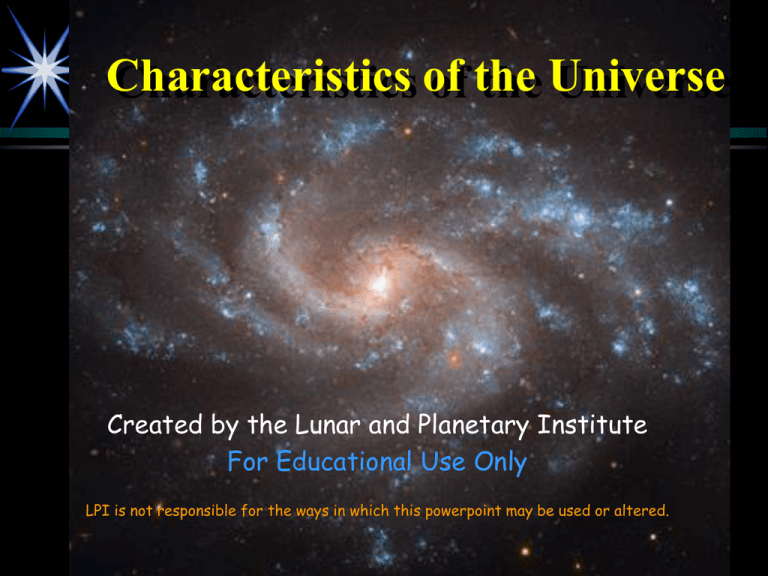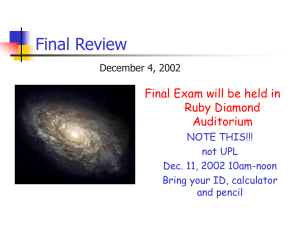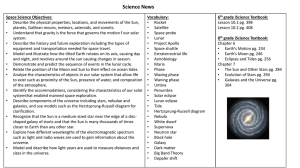Characteristics of the Universe Created by the Lunar and Planetary Institute
advertisement

Characteristics of the Universe Created by the Lunar and Planetary Institute For Educational Use Only LPI is not responsible for the ways in which this powerpoint may be used or altered. Welcome! • • Please complete the pre-assessment It’s for us—it’s not about you What are we going to cover? Our Place in the Universe Scale and Distance The Electromagnetic Spectrum Classifying Stars Classifying Galaxies History of the Universe First up… Our Place in the Universe What is our Universe made of? How big are things? How far away? How do we know? Activity!! Use the Venn diagrams to place the stickers—where does everything go? After you’re finished, let’s discuss… Examining the Components Stars Gas and dust (Nebulae) Star clusters Galaxies Different types of stars Types of Stars Big Small Red Blue Yellow In groups Alone More later What is a “star cluster”? stars formed together at same time stars may be gravitationally bound together two types: open (galactic) and globular Open Clusters dozens to thousands of young stars located in the spiral arms of a galaxy example: Pleiades Globular Clusters millions to hundreds of millions of stars, clumped closely together old! 6 to 13 billion years surround our disk as a halo What is a “nebula”? A cloud in space Made of gas and dust Can have stars inside Most of the ones we see are inside our Milky Way Galaxy Many different types, sizes, composition What is a “galaxy”? A large group of stars outside of our own Milky Way Made of billions to trillions of stars Also may have gas and dust Spiral, or elliptical, or irregular shaped Next Up Our Place in the Universe Scale and Distance The Electromagnetic Spectrum Classifying Stars Classifying Galaxies History of the Universe Measuring Distances What A light year is the distance light travels in a year. Light moves at a velocity of about 300,000 kilometers (km) each second; how far would it move in a year? About 10 trillion km (or about 6 trillion miles). Why is a Light Year? do we use light years? Show me how far 5 centimeters is. Now show me 50 centimeters. Now tell me (without thinking about it, or calculating it in meters) how far 500 centimeters is? 2000? 20,000? We need numbers that make sense to us in relationship to objects; we scale up and use meters and kilometers for large numbers. Measuring Distances Parallax (let’s model it) As Earth orbits the Sun, we see nearby stars move relative to more distant stars How many degrees did the plate move, relative to the background? The angles involved for strellar observations are very small and difficult to measure. Proxima Centauri, has a parallax of 0.77 arcsec. This angle is approximately the angle subtended by an object about 2 centimeters in diameter located about 5.3 kilometers away. Mapping the Milky Way How do we know what our Galaxy looks like? We can see stars star clusters nebulae Galaxies Let’s try to Map our Galaxy Our Galaxy: the Milky Way has about 200 billion stars, and lots of gas and dust is a barred-spiral (we think) about 100,000 light-years wide our Sun is halfway to the edge, revolving at half a million miles per hour around the center of the Galaxy takes our Solar System about 200 million years to revolve once around our galaxy The Milky Way Next Up Our Place in the Universe Scale and Distance The Electromagnetic Spectrum Classifying Stars Classifying Galaxies History of the Universe Let’s check your knowledge Please draw an electromagnetic spectrum on a sheet of paper, and label the parts. You can work in groups. Radiation There are lots of types of light (radiation), including visible and invisible Electromagnetic spectrum http://coolcosmos.ipac.caltech.edu/cosmic_classroom/ir_tutorial/what_is_ir.html . Let’s Observe A Spectrum Now let’s examine the invisible parts— using our cell phones and a solar cell. Radiation All stars emit radiation Radio, infrared, visible, ultraviolet, x-ray and even some gamma rays Most of the sunlight is yellow-green visible light or close to it The Sun at X-ray wavelengths Image and info at http://imagine.gsfc.nasa.gov/docs/teachers/gammaraybursts/imagine/page18.html Using a Star’s Spectrum We can use a star’s spectrum to classify it. Stellar Evolution Time to Create a Stellar Graph Everyone will receive several “stars” Place them on the large paper, according to their color and their brightness This is a version of the Hertzsprung-Russell diagram. Hertzsprung-Russell Diagram Images from http://www.nasa.gov/centers/goddard/news/topstory/2007/spectrum_plants.html and http://sunearthday.gsfc.nasa.gov/2009/TTT/65_surfacetemp.php Young stars form in nebulae A Star is Born Movie at http://www.stsci.edu/EPA/PR/95/44/M16.mpg Regular/ Small Star On the “Main Sequence” Red Giant White Dwarf Small, but very hot Massive Stars On the “main Sequence” but not for long Betelgeuse—Red Supergiant Supernova—Massive Star Explodes Neutron Star or Pulsar Image at http://hubblesite.org/newscenter/archive/releases/nebula/supernova-remnant/2002/24/results/50/ Black Hole Galaxies come in different sizes (dwarf, large, giant) come in different shapes and classifications Spirals Ellipticals Lenticulars Irregulars are fairly close together, relative to their sizes Collisions! We now think that galaxies in groups and clusters often collide The Milky Way is moving at 300,000 mph toward the Andromeda Galaxy They may collide in about 5 billion years Stars don’t usually collide New orbits, gas piles up to form new stars Galaxies Spiral galaxy--Andromeda Elliptical Galaxies group of galaxies interacting Interacting Cluster Origin of the Universe • Big Bang • • • Dominant scientific theory about the origin of the universe Occurred ~13.7 billion years ago How do we know???? http://www.esa.int/esaCP/ESAKD7G18ZC_FeatureWeek_1.html Building a Universe . • Infinitely dense point not governed by our physical laws or time • All matter and energy contained in one point Building a Universe • The Big Bang Instantaneous filling of space with all matter Edwin Hubble http://en.wikipedia.org/wiki/File:Edwin_Hubble_with_pipe.jpg • Showed that universe is continuously expanding • Galaxy’s velocity is proportional to its distance (galaxies that are twice as far from us move twice as fast) • taken every galaxy the same amount of time to move from a common starting position to its current position Hubble’s Evidence • Doppler shifting - wavelength emitted by something moving away from us is shifted to a lower frequency • Visible wavelengths emitted by objects moving away from us are shifted towards the red part of the visible spectrum. The faster they move away from us, the more they are redshifted. • When we observe the redshift of galaxies outside our local group, every galaxy appears to be moving away from us - Universe is expanding. Evidence for Big Bang Red shift - as light from distant galaxies approach earth there is an increase of space between earth and the galaxy, which leads to wavelengths being stretched • • • In 1964, Arno Penzias and Robert Wilson, discovered a noise of extraterrestrial origin that came from all directions at once radiation left over from the Big Bang In June 1995, scientists detected helium in the far reaches of the universe - consistent with an important aspect of the Big Bang theory that a mixture of hydrogen (75%) and helium (25%) was created at the beginning of the universe Feedback, Questions Reach us online at http://www.lpi.usra.edu/education/ For more information, contact Christine Shupla Lunar and Planetary Institute 3600 Bay Area Blvd Houston, TX 77058 (281) 486-2135 shupla@lpi.usra.edu







